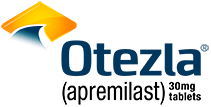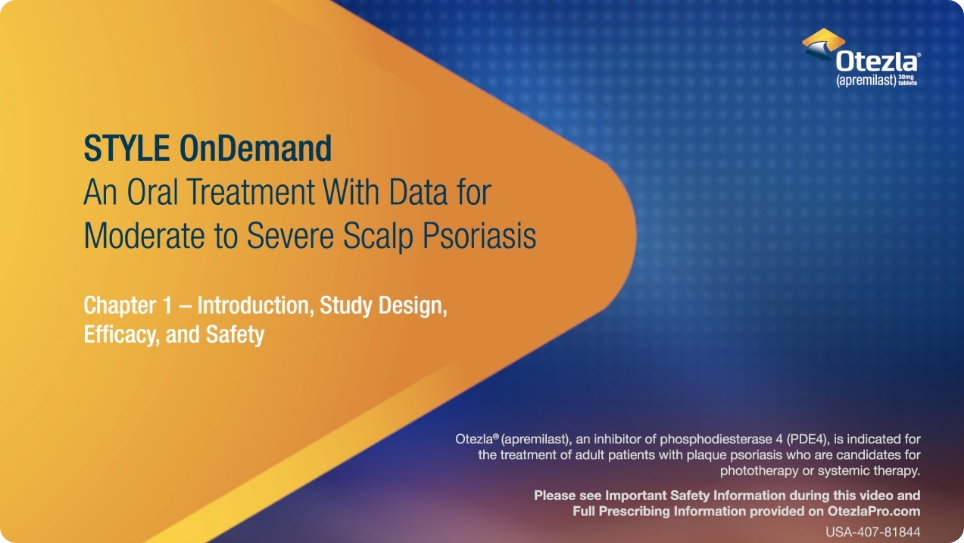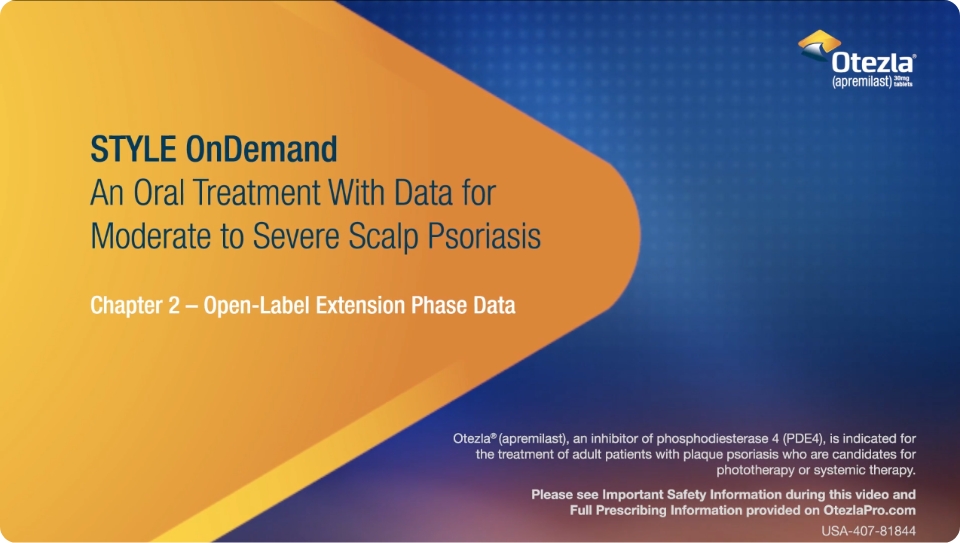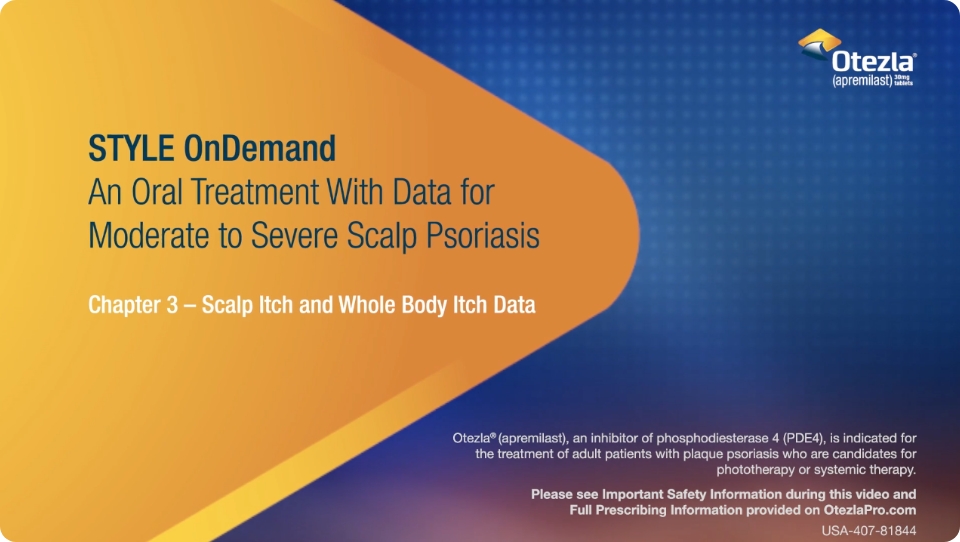Otezla Is the Only Oral Therapy With Scalp Data in Its Label 1
Chapter 1
Dr. Cather: Thank you for joining us. Please see important safety information during
this video and the full prescribing information on OtezlaPro.com.
Dr. Cather: Hi, my name is Jennifer Cather, and I’m a dermatologist at Mindful
Dermatology in Dallas, Texas. Today I’ll be speaking on behalf of Amgen about Otezla, also known as apremilast.
Dr. Cather: Otezla is a non-biologic, phosphodiesterase 4 inhibitor indicated for the
treatment of adult patients with plaque psoriasis who are candidates for phototherapy or systemic therapy.
Otezla is contraindicated in patients with a known hypersensitivity to apremilast or to any of the excipients in
the formulation.
Reference: 1. Otezla® (apremilast) prescribing information, Amgen.
Dr. Cather: With an FDA-approved label expansion in April 2020, Otezla is the first
and only oral therapy with data in the label for moderate to severe scalp psoriasis. Today we’ll review these
data in detail.
Reference: 1. Amgen. Label Expansion: Amgen's Otezla Adds Scalp Data.
https://practicaldermatology.com/news/label-expansion-amgens-otezla-adds-scalp-data. Accessed March 28, 2022.
Dr. Cather: Before we dive into the clinical trial for moderate to severe psoriasis of
the scalp, let’s briefly review one of the two registrational trials for moderate to severe plaque psoriasis,
ESTEEM 1.
Reference: 1. Otezla® (apremilast) prescribing information, Amgen.
Dr. Cather: ESTEEM 1 was a phase 3, randomized, placebo-controlled trial that enrolled
844 adult patients with moderate to severe plaque psoriasis. Patients were randomized 2:1 to receive Otezla 30
milligrams twice daily or placebo up to week 16.
Reference: 1. Papp K, et al. J Am Acad Dermatol. 2015;73:37-49.
Dr. Cather: Selected inclusion criteria for the study include an sPGA of at least 3,
indicative of moderate to severe disease, as well as BSA involvement of at least 10%, and a PASI score of at
least 12. Patients were also candidates for phototherapy or systemic therapy.1
The primary endpoint of the study was the proportion of patients achieving a PASI-75, or 75% clearer skin, at
week 16. 2
References: 1. Otezla® (apremilast) prescribing information, Amgen. 2. Papp K,
et al. J Am Acad Dermatol. 2015;73:37-49.
Dr. Cather: Here, we can see the primary endpoint was achieved in the ESTEEM 1 trial.
Otezla treatment resulted in significantly more patients achieving a PASI-75 response at week 16, compared with
placebo.
Specifically, a total of 33% of patients on Otezla achieved a response versus 5% of patients on placebo.
Reference: 1. Papp K, et al. J Am Acad Dermatol. 2015;73:37-49.
Dr. Cather: Now let’s review the STYLE clinical trial, which evaluated the efficacy and
safety of Otezla for adult patients with moderate to severe plaque psoriasis of the scalp.
Reference: 1. Van Voorhees AS, et al. J Am Acad Dermatol. 2020;83:96-103.
Dr. Cather: STYLE was a phase 3, randomized, double blind, placebo-controlled trial
that enrolled a total of 303 adult patients with moderate to severe scalp psoriasis. Patients were randomized
2:1 to receive either Otezla or placebo for 16 weeks.
The open-label extension phase lasted from week 16 to week 32. During this phase, patients in the placebo arm
were switched to Otezla, and patients randomized to Otezla at baseline continued treatment.
Reference: 1. Van Voorhees AS, et al. J Am Acad Dermatol. 2020;83:96-103.
Dr. Cather: The primary endpoint of the STYLE trial was the proportion of patients at
week 16 who achieved a Scalp Physician’s Global Assessment response, or scalp PGA, score of 0, indicating clear
skin, or 1, indicating almost clear skin, with at least a 2-point reduction from baseline. 1
To be included in the study, patients were adults aged 18 years or more, with both moderate to severe plaque
psoriasis and moderate to severe scalp psoriasis. Specifically, moderate to severe psoriasis was defined as a
BSA involvement of at least 10%, an sPGA of at least 3, and a PASI score of at least 12, while moderate to
severe scalp psoriasis was defined as a scalp PGA of at least 3 and a scalp surface area of at least 20.
1
Patients were also candidates for phototherapy or systemic therapy. 2
References: 1. Van Voorhees AS, et al. J Am Acad Dermatol. 2020;83:96-103. 2.
Data on file, Amgen.
Dr. Cather: At baseline, all patients in STYLE had moderate or severe scalp psoriasis.
References: 1. Van Voorhees AS, et al. J Am Acad Dermatol. 2020;83:96-103. 2.
Data on file, Amgen.
Dr. Cather: The primary endpoint in STYLE was achieved with Otezla treatment, resulting
in significantly more patients achieving a scalp PGA response at week 16 compared with placebo.
Specifically, 43.3% of patients on Otezla achieved a response versus 13.7% of patients on placebo.
If you’re interested in learning about the scalp PGA response at a longer time point, be sure to click on the
appropriate link at the end of this presentation.
References: 1. Van Voorhees AS, et al. J Am Acad Dermatol. 2020;83:96-103. 2.
Data on file, Amgen.
Dr. Cather: Here we see an example of results in a scalp psoriasis patient from the
STYLE trial.
While individual results may vary, in this case we see a scalp PGA score of 0 with a 3-point improvement from
baseline at 16 weeks with Otezla.
Reference: 1. Data on file, Amgen.
Dr. Cather: Now let’s review in more detail the safety data from the Otezla clinical
trials.
Dr. Cather: Adverse reactions reported in at least 5% of patients in 3 clinical trials,
including ESTEEM, were diarrhea, nausea, upper respiratory tract infection, tension headache, and headache.
Reference: 1. Otezla® (apremilast) prescribing information, Amgen.
Dr. Cather: The most common adverse reactions observed in the STYLE trial that were
reported in at least 5% of patients taking Otezla were diarrhea, nausea, headache, and vomiting.
Discontinuation of treatment due to any adverse reaction during the placebo-controlled period was 6% for patients
taking Otezla and 3% for placebo.
Discontinuation rates due to diarrhea, nausea, or vomiting in patients who received Otezla versus placebo were 3%
versus 0% for diarrhea, 1.5% versus 1% for nausea, and 1.5% versus 0% for vomiting, respectively.
Please note, the Prescribing Information for Otezla has no requirement for baseline or routine lab monitoring.
Reference: 1. Otezla® (apremilast) prescribing information, Amgen.
VO:
Important Safety Information
Warnings and Precautions
Hypersensitivity: Hypersensitivity reactions, including angioedema and anaphylaxis, have been reported during
postmarketing surveillance. If signs or symptoms of serious hypersensitivity reactions occur, discontinue Otezla
and institute appropriate therapy.
Diarrhea, Nausea, and Vomiting: Cases of severe diarrhea, nausea, and vomiting were associated with the use of
Otezla. Most events occurred within the first few weeks of treatment. In some cases, patients were hospitalized.
Patients 65 years of age or older and patients taking medications that can lead to volume depletion or
hypotension may be at a higher risk of complications from severe diarrhea, nausea, or vomiting. Monitor patients
who are more susceptible to complications of diarrhea or vomiting; advise patients to contact their healthcare
provider. Consider Otezla dose reduction or suspension if patients develop severe diarrhea, nausea, or vomiting.
Depression: Carefully weigh the risks and benefits of treatment with Otezla for patients with a history of
depression and/or suicidal thoughts or behavior, or in patients who develop such symptoms while on Otezla.
Patients, caregivers, and families should be advised of the need to be alert for the emergence or worsening of
depression, suicidal thoughts or other mood changes, and they should contact their healthcare provider if such
changes occur
Treatment with Otezla is associated with an increase in depression. During clinical trials in patients with
moderate to severe plaque psoriasis, 1.3% of patients reported depression compared to 0.4% on placebo.
Depression was reported as serious in 0.1% of patients exposed to Otezla, compared to none in placebo-treated
patients. Suicidal behavior was observed in 0.1% of patients on Otezla, compared to 0.2% on placebo. One patient
treated with Otezla attempted suicide; one patient on placebo committed suicide.
Weight Decrease: Monitor body weight regularly; evaluate unexplained or clinically significant weight loss, and
consider discontinuation of Otezla.
Body weight loss of 5 to 10% occurred in 12% of patients with moderate to severe plaque psoriasis treated with
Otezla and in 5% of patients treated with placebo. Body weight loss of 10% or more occurred in 2% of patients
treated with Otezla compared to 1% of patients treated with placebo.
Drug Interactions: Apremilast exposure was decreased when Otezla was co-administered with rifampin, a strong
CYP450 enzyme inducer; loss of Otezla efficacy may occur. Concomitant use of Otezla with CYP450 enzyme inducers
(for example, rifampin, phenobarbital, carbamazepine, phenytoin) is not recommended.
Adverse Reactions
The most common adverse reactions (5% or more) are diarrhea, nausea, upper respiratory tract infection, and
headache, including tension headache. Overall, the safety profile of Otezla in patients with mild to moderate
plaque psoriasis was consistent with the safety profile previously established in adult patients with moderate
to severe plaque psoriasis
Use in Specific Populations
Otezla has not been studied in pregnant women. Advise pregnant women of the potential risk of fetal loss.
Please see the Full Prescribing Information for Otezla provided on OtezlaPro.com.
Reference: 1. Otezla® (apremilast) prescribing information, Amgen.
Dr. Cather: So to summarize some key facts about Otezla, first, there is no requirement
for routine laboratory monitoring from the Prescribing Information. 1
Additionally, regarding safety, it’s important to remember that in the psoriasis trials, the majority of patients
reporting nausea and diarrhea did so within the first 2 weeks, and the events tended to resolve over time with
continued dosing. 2
Postmarketing reports of severe diarrhea, nausea, and vomiting have been associated with the use of Otezla, and
in some cases patients were hospitalized, so patients who are more susceptible to complications of diarrhea or
vomiting should be monitored. 1
As the data from the STYLE trial that we reviewed today were included in the label expansion, Otezla is the only
oral therapy with data in the label for moderate to severe scalp psoriasis.
References: 1. Otezla® (apremilast) prescribing information, Amgen. 2. Papp K,
et al. J Am Acad Dermatol. 2015;73:37-49
Dr. Cather: Thank you for listening. Click one of these options to learn more about the STYLE
trial and Otezla.
Chapter 2
Dr. Cather: Hello again. To briefly review what we’ve learned so far, the STYLE
clinical trial was a phase 3, multicenter, randomized, double-blind, and placebo-controlled study that evaluated
the efficacy and safety of Otezla in patients with moderate to severe plaque psoriasis of the scalp.
In the placebo-controlled phase, patients were randomized 2:1 and were administered Otezla 30 milligrams twice
daily or placebo for 16 weeks.
Reference: 1. Van Voorhees AS, et al. J Am Acad Dermatol. 2020;83:96-103.
Dr. Cather: The primary endpoint was the proportion of patients who
achieved a scalp PGA response of 0, indicating clear skin, or 1, indicating almost clear skin, with at least a
2-point reduction from baseline after 16 weeks of treatment.
As we’ve already reviewed, this primary endpoint was achieved as analyzed using a multiple imputation analysis.
Reference: 1. Van Voorhees AS, et al. J Am Acad Dermatol. 2020;83:96-103.
Dr. Cather: Week 16 to week 32 of the trial comprised the open-label extension phase,
where at week 16 patients in the placebo arm were switched to Otezla, and patients initiated on Otezla continued
treatment for another 16 weeks.
All data in the open-label extension phase were analyzed using a non-responder imputation, or NRI, analysis.
Reference: 1. Van Voorhees AS, et al. J Am Acad Dermatol. 2020;83:96-103.
Dr. Cather: Here we can see the results from the open-label extension phase of the
study.
Keep in mind that this phase was not blinded and not controlled, and included inherent self-selection bias for
remaining in the trial.
In this exploratory NRI analysis, the percentage of patients achieving a scalp PGA response at week 16 was 38.8%
for Otezla versus 10.8% for placebo.
At week 32, a total of 44.8% of patients who started on Otezla and 60.7% of patients who switched to Otezla
achieved a scalp PGA response.
Reference: 1. Data on file, Amgen.
Dr. Cather: In the STYLE clinical trial, the most common adverse reactions reported in
at least 5% of patients taking Otezla include diarrhea, nausea, headache, and vomiting.
Discontinuation of treatment due to any adverse reaction during the placebo-controlled period was 6% for patients
taking Otezla and 3% for placebo.
Specifically, discontinuation rates due to diarrhea, nausea, or vomiting in patients who received Otezla vs
placebo were 3% versus 0% for diarrhea, 1.5% versus 1% for nausea, and 1.5% versus 0% for vomiting,
respectively.
Reference: 1. Otezla® (apremilast) prescribing information, Amgen.
Dr. Cather: During the open-label extension phase, discontinuation due to an adverse
reaction was 3.0% for patients remaining on Otezla and 1.2% for patients who switched to Otezla.
This chart shows the adverse reactions reported in at least 2% of patients in any treatment group during the
open-label extension phase from weeks 16 to 32.
The most common adverse reactions in patients who remained on Otezla were nausea, nasopharyngitis, and urinary
tract infection. For patients who switched to Otezla, the most common adverse reactions were diarrhea and
nausea.
Reference: 1. Data on file, Amgen.
Dr. Cather: Here, we can see an example from a patient treated with Otezla in the STYLE
trial.
While individual results may vary, in this case we see a scalp PGA score of 3 with a 1-point improvement from
baseline at 16 weeks with Otezla.
Reference: 1. Data on file, Amgen.
Dr. Cather: Here’s another example of results from a different patient treated with
Otezla at both week 16 and at week 32.
While individual results may vary, in this case we see a scalp PGA score of 2 with a 1-point improvement from
baseline at 16 weeks with Otezla, and a scalp PGA score of 1 with a 2-point improvement from baseline at 32
weeks with Otezla.
Reference: 1. Data on file, Amgen.
Dr. Cather: So to summarize, the STYLE clinical trial provided scalp PGA responses for
up to 32 weeks as part of the exploratory open-label extension phase. 1
The most common adverse reactions in the STYLE trial were diarrhea, nausea, headache, and vomiting.
2
Notably, Otezla is the only oral therapy with data in the label for moderate to severe scalp psoriasis
References: 1. Data on file, Amgen; 2. Van Voorhees AS, et al. J Am Acad
Dermatol. 2020;83:96-103.
Dr. Cather: Thank you for listening. Click on one of these buttons to learn more about
the STYLE trial and Otezla.
Chapter 3
Dr. Cather: Hello again. To recap what we’ve learned so far, the STYLE clinical trial
was a phase 3, randomized, double-blind, placebo-controlled study of adult patients that evaluated the efficacy
and safety of Otezla in patients with moderate to severe plaque psoriasis of the scalp.
Patients were randomized 2:1 and were administered Otezla 30 milligrams twice daily or placebo for 16 weeks.
During the open-label extension phase, at week 16, patients in the placebo arm were switched to Otezla and
patients initiated on Otezla continued treatment for another 16 weeks.
Reference: 1. Van Voorhees AS, et al. J Am Acad Dermatol. 2020;83:96-103.
Dr. Cather: As we’ve already reviewed, the primary endpoint of the proportion of
patients who achieved a scalp PGA response of 0 or 1 at week 16 was achieved.
Reference: 1. Van Voorhees AS, et al. J Am Acad Dermatol. 2020;83:96-103.
Dr. Cather: Let’s now review selected secondary endpoints, namely the proportion of
patients with at least a 4-point reduction from baseline in scalp itch and whole body itch as measured by the
numeric rating scale, or NRS, at weeks 2, 4, 8, 12, and 16 and analyzed by a multiple imputation analysis.
Reference: 1. Van Voorhees AS, et al. J Am Acad Dermatol. 2020;83:96-103.
Dr. Cather: For scalp itch, Otezla treatment resulted in significantly more patients
achieving at least a 4-point improvement from baseline in scalp itch NRS score at week 16 compared with placebo,
with 47.1% of patients on Otezla achieving a response versus 21.1% of patients on placebo.
Reference: 1. Van Voorhees AS, et al. J Am Acad Dermatol. 2020;83:96-103.
Dr. Cather: Notably, a significant improvement in scalp itch was seen as early as 2
weeks with Otezla treatment. At the 2-week mark, 26.1% of patients on Otezla achieved a scalp itch response
versus 11.5% of patients on placebo.
Reference: 1. Van Voorhees AS, et al. J Am Acad Dermatol. 2020;83:96-103.
Dr. Cather: We also see a significant improvement in whole body itch with Otezla
treatment, as after 16 weeks of treatment, 45.5% of patients on Otezla achieved at least a 4-point improvement
from baseline in whole body itch NRS score as compared with 22.5% of patients on placebo.
Reference: 1. Van Voorhees AS, et al. J Am Acad Dermatol. 2020;83:96-103.
Dr. Cather: Notably, a significant improvement in whole body itch was also seen as
early as 2 weeks with Otezla treatment, with 20.5% of patients on Otezla achieving a whole body itch response
versus 3.5% of patients on placebo.
Reference: 1. Van Voorhees AS, et al. J Am Acad Dermatol. 2020;83:96-103.
Dr. Cather: In the STYLE clinical trial, the most common adverse reactions reported in
at least 5% of patients taking Otezla include diarrhea, nausea, headache, and vomiting.
Discontinuation of treatment due to any adverse reaction during the placebo-controlled period was 6% for patients
taking Otezla and 3% for placebo.
Specifically, discontinuation rates due to diarrhea, nausea, or vomiting in patients who received Otezla versus
placebo were 3% versus 0% for diarrhea, 1.5% versus 1% for nausea, and 1.5% versus 0% for vomiting,
respectively.
Reference: 1. Otezla® (apremilast) prescribing information, Amgen.
Dr. Cather: In summary, 16 weeks of Otezla treatment showed significant improvement in
scalp and whole body itch, with a significant improvement seen as early as 2 weeks. 1
The most common adverse reactions in the STYLE trial were diarrhea, nausea, headache, and vomiting.
1
The week 16 data from the STYLE trial that we reviewed today were included in the label expansion for Otezla,
making it the only oral therapy with data in the label for moderate to severe scalp psoriasis. 2
References: 1. Van Voorhees AS, et al. J Am Acad Dermatol. 2020;83:96-103. 2.
Otezla® (apremilast) prescribing information, Amgen.
Dr. Cather: Thank you for listening. Click on one of these buttons to learn more about
the STYLE trial and Otezla.








